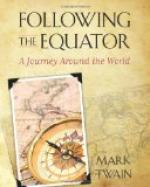The resemblances do exist, it is quite true; and often they cunningly approximate the originals—but after all, in the matter of certain physical patent rights there is only one England. Now that I have sampled the globe, I am not in doubt. There is a beauty of Switzerland, and it is repeated in the glaciers and snowy ranges of many parts of the earth; there is a beauty of the fiord, and it is repeated in New Zealand and Alaska; there is a beauty of Hawaii, and it is repeated in ten thousand islands of the Southern seas; there is a beauty of the prairie and the plain, and it is repeated here and there in the earth; each of these is worshipful, each is perfect in its way, yet holds no monopoly of its beauty; but that beauty which is England is alone—it has no duplicate.
It is made up of very simple details—just grass, and trees, and shrubs, and roads, and hedges, and gardens, and houses, and vines, and churches, and castles, and here and there a ruin—and over it all a mellow dream-haze of history. But its beauty is incomparable, and all its own.
Hobart has a peculiarity—it is the neatest town that the sun shines on; and I incline to believe that it is also the cleanest. However that may be, its supremacy in neatness is not to be questioned. There cannot be another town in the world that has no shabby exteriors; no rickety gates and fences, no neglected houses crumbling to ruin, no crazy and unsightly sheds, no weed-grown front-yards of the poor, no back-yards littered with tin cans and old boots and empty bottles, no rubbish in the gutters, no clutter on the sidewalks, no outer-borders fraying out into dirty lanes and tin-patched huts. No, in Hobart all the aspects are tidy, and all a comfort to the eye; the modestest cottage looks combed and brushed, and has its vines, its flowers, its neat fence, its neat gate, its comely cat asleep on the window ledge.
We had a glimpse of the museum, by courtesy of the American gentleman who is curator of it. It has samples of half-a-dozen different kinds of marsupials—[A marsupial is a plantigrade vertebrate whose specialty is its pocket. In some countries it is extinct, in the others it is rare. The first American marsupials were Stephen Girard, Mr. Aston and the opossum; the principal marsupials of the Southern Hemisphere are Mr. Rhodes, and the kangaroo. I, myself, am the latest marsupial. Also, I might boast that I have the largest pocket of them all. But there is nothing in that.]—one, the “Tasmanian devil;” that is, I think he was one of them. And there was a fish with lungs. When the water dries up it can live in the mud. Most curious of all was a parrot that kills sheep. On one great sheep-run this bird killed a thousand sheep in a whole year. He doesn’t want the whole sheep, but only the kidney-fat. This restricted taste makes him an expensive bird to support. To get the fat he drives his beak in and rips it out; the wound is mortal. This parrot furnishes




